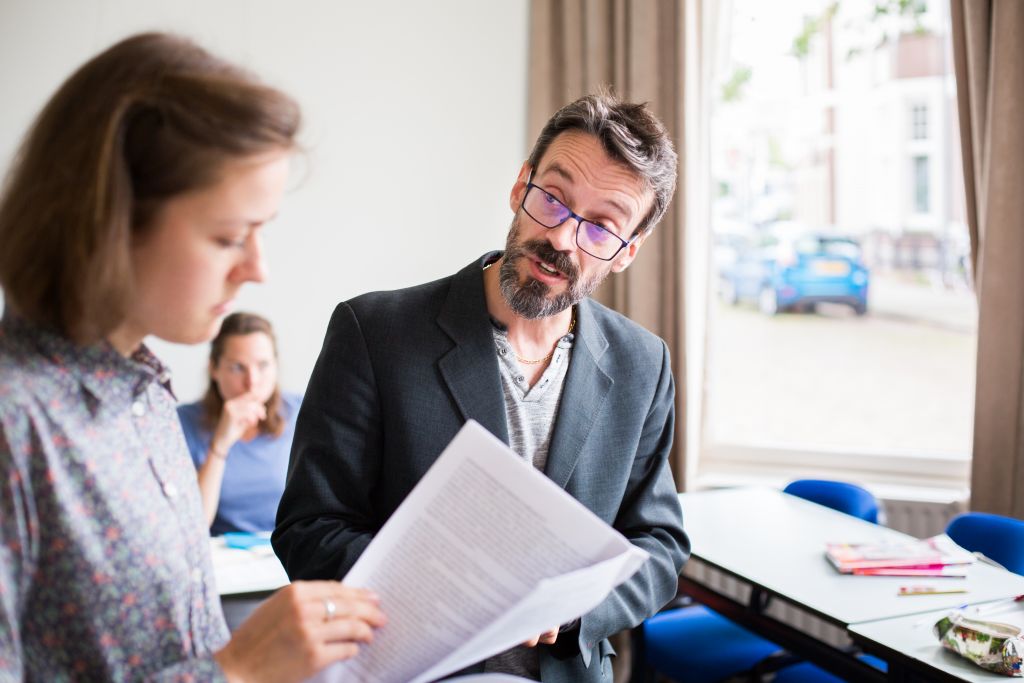Chronicles of a French teacher:
Have you ever heard of the CEFRL?

PASCAL MILARD
French teacher at Alliance Française de La Haye
It is the Common European Framework of Reference for Languages, some people call it “the Bible for language teachers” because it contains the essence of what determines all language learning.
You probably have some idea of what levels A1, A2, B1, B2, C1 and C2 can mean. The CEFR determined these language levels for all European languages in 2001 when this book of about 200 pages in A4 format was first published (a good read for cold winters!) Before that, each country chose its own gradation of language progression according to criteria and levels of expectation that could often vary from one country to another. It is easy to understand that
if Europe wanted a political, economic and social union, it was necessary above all to start and determine our means of communication.
Something that may seem obvious today but was not yet perfectly clear at the beginning of the 21st century. It is worth to be reminded that this book took more than 20 years to be conceived by hundreds of researchers, linguists and other experts.
The original idea was to find together clear references to determine what level of language proficiency a speaker was at. This is essential for a better understanding of all forms of discussions. Imagine, for example, two diplomats from different countries, meeting and using a third language to understand each other. Suppose that each of them has learned this same language but with two completely different evaluation systems. There would be a good chance that one of them would find himself totally ridiculous in front of his counterpart. You can imagine that this situation has happened more than once!
Of course, the CEFR was not created solely to avoid any form of diplomatic vexation. Above all, it gives Europeans greater incentive to know their neighbours language as they have a better idea of their learning objectives, thanks to well-established stages of progression based on concrete know-how. This idea is very much in line with the prerogatives of the European Union and, in particular, one of its principles, that is to intensify exchanges between the peoples of the continent around common concepts. We must not forget the great interest that this document can have for language teachers, whether in a school learning context or in continuing education for adults. To use a maritime expression, the CEFRL gives teachers the opportunity to go beyond “sailing on sight” and to set up a programme adapted to a clear framework with very explicit tools, such as a scale of values integrating the different skills and abilities to be mastered in order to reach a given level.
In reverse, today, when you know your level of French based on the CEFRL, you can very concretely adapt it to life choices that are decisive for you. If I have a B1 level, I can very well choose to live in France and be able to manage in everyday situations. When I have completed my B2 level, I can claim to work for an international organization which counts French among the languages of use. This is aptly named,
it is about giving Europeans common references in order to better understand each other and evolve in the same direction.
The resulting diplomas and qualifications, which are recognised by all institutions and companies, value all learning efforts and prove on your CV that a language you have learned is indeed mastered and that you are not simply saying that your level in this language is OK, correct, I manage, etc.
In conclusion, we can admit that never before has a book analyzed to this extent the common aspects of European languages concerning the construction of linguistic knowledge and give all these languages the same value while respecting their uniqueness. It is the sum of all the sociolinguistic knowledge accumulated and placed in a mutual effort, a shared “faith” so that each of us can situate ourselves in this interconnected world. It is a point of reference that places us all on the same platform on which we all evolve with the same criteria for progress, without seeking to value one language more than another. In particular, sign language for the deaf and hard-of-hearing integrates the levels of the CEFRL for its learning.
To find out more about this Common European Framework of Reference for Languages, please follow the following link https://www.coe.int/fr/web/common-european-framework-reference-languages
or even if you want you can download this book for free here. https://rm.coe.int/16802fc3a8
Note that this book offers many assessment tools which, beyond the grids used for official diplomas such as DELF or TOEFL, also proposes a very effective means of self-assessment called Dialang. If you want to know more and test yourself, click on the following link. https://dialangweb.lancaster.ac.uk/
In a future article, we will discuss this notion of self-directed and e-learning and its current effectiveness.

